Richard Wilson’s new sculpture for Heathrow’s Terminal 2
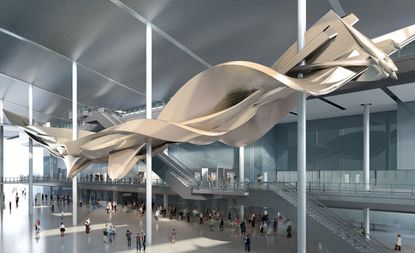
Within the realm of contemporary sculpture, Richard Wilson’s technically wondrous creations force us to rethink our ideas of space, perspective, material and structure. Which is why Heathrow Airport needed little coaxing when it came to choosing the British-born artist to create an installation for the soon-to-be renovated Terminal 2.
Sporting a dramatic wave-like roof, the shiny new terminal – which is due to open in 2014 - is swiftly taking shape under the direction of Foster + Partners, in collaboration with Luis Vidal and HETCo. The new space will feature a central light-filled courtyard (similar in size to the Tate Modern’s Turbine Hall) in which Wilson’s oscillating structure, titled ‘Slipstream’, will be suspended 20m above the ground.
‘This work is a metaphor for travel,’ says Wilson of the design. ‘It is a journey from A to B, where sensations of velocity, acceleration and de-acceleration follow us at every undulation.’
Inspired by photographer Eadweard Muybridge, whose series ‘Human figure in Motion’ captured moving moments, Wilson’s mission was to create a sculpture that did just that. ‘If you set your lens at one-thousandth of a second, you can capture that wonderful moment in time,’ explains Wilson.
Using the somersaulting, spiralling and twisting motions of a small stunt plane in flight, Wilson started off with a series of sketches and then enlisted the help of structural engineers Price & Myers as well as specialist fabricators Commercial Systems International (CSI), who used aeronautical computer technology to translate his concept into a three-dimensional reality.
Measuring over 70 metres long and weighing in at 77 tonnes, the larger-than-life creation will be formed by a wooden skeleton covered in plywood, while the external layer will be fashioned out of semi-polished aluminium. ‘A very elegant sculpture, with a streamlined, undulating surface that reflects the light in all sorts of ways,’ says Wilson of his creation. 'The riveted aluminium surface will highlight the contours of the piece.’
Wilson’s sculptures never cease to inspire and provoke, and ‘Slipstream’ is bound to be a visual delight, reminding us that the boundaries as we know them are only the beginning.

Sporting a dramatic wave-like roof, the shiny new terminal – which is due to open in 2014 - is swiftly taking shape under the design work of Foster Partners, in collaboration with Luis Vidal and HETCo
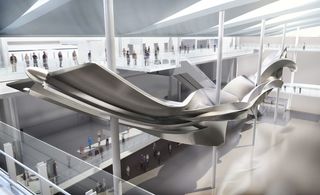
The new space will feature a central light-filled courtyard (similar in size to the Tate Modern’s Turbine Hall) in which Wilson’s oscillating structure, titled ‘Slipstream’, will be suspended 20m above the ground

Inspired by photographer Eadweard Muybridge, whose series ‘Human figure in Motion’, captured moving moments, Wilson’s mission was to create a sculpture that did just that

Using the somersaulting, spiralling and twisting motions of a small stunt plane in flight, Wilson started off with a series of sketches

One of Wilson's original sketches depicting a plane in motion
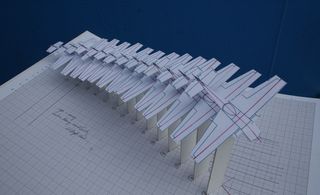
He then enlisted the help of structural engineers Price & Myers as well as specialist fabricators Commercial Systems International (CSI) who used aeronautical computer technology to translate his concept into a three dimensional reality

The three dimensional stage after the sketches, showing the mathematical process used to create the final models and renderings

The final solid model, created to the same scale used in aeroplane designs
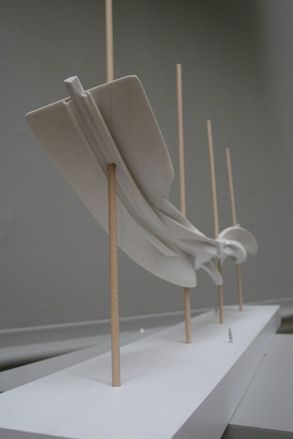
A view of the solid model from underneath
The final rendering showing the plane's movement, depicting its undulations, twistings and spirallings and eventually, the beginning of the sculpture. 'Once out the other side, imagine the vast void left by the plane’s path is filled with fast-setting plaster, therefore making the void the solid,' explains Wilson
Wallpaper* Newsletter
Receive our daily digest of inspiration, escapism and design stories from around the world direct to your inbox
Lauren Ho is the former travel editor at Wallpaper*. Now a contributing editor, she roams the globe, writing extensively about luxury travel, architecture and design for both the magazine and the website, alongside various other titles. She is also the European Academy Chair for the World's 50 Best Hotels.
-
 Ikea introduces its first gaming furniture collection
Ikea introduces its first gaming furniture collectionBrännboll is the first Ikea gaming furniture collection, unveiled during Milan Design Week 2024 and designed to swiftly transform a domestic space into a gamer’s paradise
By Jasper Spires Published
-
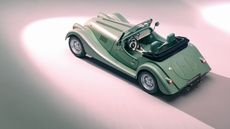 Morgan take their classic roadster and give it subtle but significant tweaks for 2024
Morgan take their classic roadster and give it subtle but significant tweaks for 2024New details and features give the compulsive Morgan Plus Four an even more pared back silhouette and driving ability
By Jonathan Bell Published
-
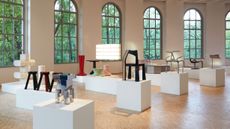 Wallpaper* Class of '24 exhibition now open at Triennale Milano
Wallpaper* Class of '24 exhibition now open at Triennale MilanoWallpaper* Class of '24 exhibition at Triennale spotlights international emerging talent in furniture and product design, with the support of AHEC and SNOW (until 21 April 2024)
By Rosa Bertoli Published
-
 Anglepoise and National Trust look to Britain’s coastal landscape for a new blue lighting collection
Anglepoise and National Trust look to Britain’s coastal landscape for a new blue lighting collectionAnglepoise and National Trust announce their third lighting collection, Neptune Blue
By Hannah Silver Published
-
 Designer James Shaw’s latest creation is a self-built home in east London
Designer James Shaw’s latest creation is a self-built home in east LondonJames Shaw's east London home is Filled with vintage finds and his trademark extruded plastic furniture, a compact self-built marvel
By Rosa Bertoli Published
-
 Art’otel Battersea opens with immersive interiors by Jaime Hayon
Art’otel Battersea opens with immersive interiors by Jaime HayonAn exclusive tour of Art’otel Battersea, the first UK opening from the group, located opposite the Battersea Power Station and featuring immersive interiors by Jaime Hayon
By Rosa Bertoli Published
-
 Ælfred: the new east London destination for vintage Scandinavian design
Ælfred: the new east London destination for vintage Scandinavian designÆlfred opens in Hackney Wick, offering democratically priced Scandinavian furniture, lighting, ceramics and glassware
By Emma O'Kelly Published
-
 Hyperlocal design: these Atelier100 products are made within 100km of London
Hyperlocal design: these Atelier100 products are made within 100km of LondonAtelier100 launches its retail space and debut locally focused design collection in London’s Hammersmith
By Martha Elliott Published
-
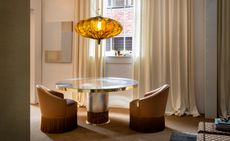 Dimoremilano opens immersive Marylebone residency around Frieze London 2022
Dimoremilano opens immersive Marylebone residency around Frieze London 2022Coinciding with this year’s Frieze London, Dimoremilano has opened an immersive residency at The Invisible Collection’s new Marylebone HQ
By Mary Cleary Last updated
-
 Holloway Li’s debut furniture collection is like colourful candy
Holloway Li’s debut furniture collection is like colourful candyHolloway Li presents the ‘T4’ collection of furniture, created in collaboration with Turkish manufacturer Uma and inspired by the designers’ 1990s childhood
By Rosa Bertoli Last updated
-
 Bill Amberg creates leather furniture in collaboration with the Knepp Estate
Bill Amberg creates leather furniture in collaboration with the Knepp EstateLondon-based designer Bill Amberg has created a series of furniture pieces for the Knepp Estate, Sussex, using leather from the rewilding project's animals for an on-site cafe due to open in 2023
By Giovanna Dunmall Last updated